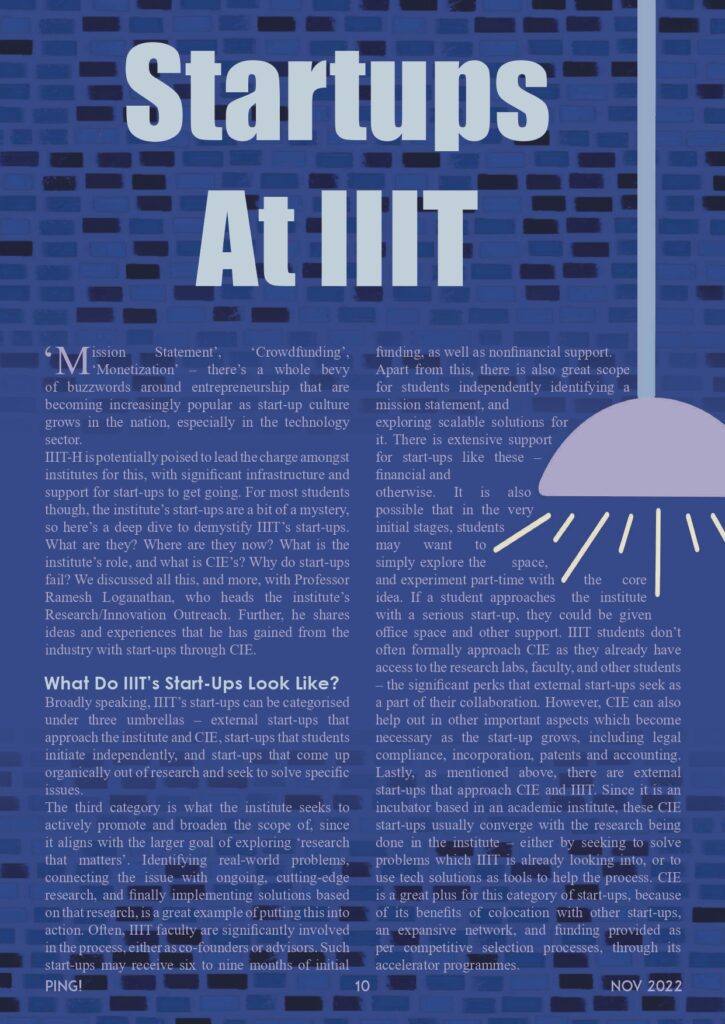Startups at IIIT
‘Mission Statement’, ‘Crowdfunding’, ‘Monetization’ – there’s a whole bevy of buzzwords around entrepreneurship that are becoming increasingly popular as start-up culture grows in the nation, especially in the technology sector.
IIIT-H is potentially poised to lead the charge amongst institutes for this, with significant infrastructure and support for start-ups to get going. For most students though, the institute’s start-ups are a bit of a mystery, so here’s a deep dive to demystify IIIT’s start-ups. What are they? Where are they now? What is the institute’s role, and what is CIE’s? Why do start-ups fail? We discussed all this, and more, with Professor Ramesh Loganathan, who heads the institute’s Research/Innovation Outreach. Further, he shares ideas and experiences that he has gained from the industry with start-ups through CIE.
What do IIIT’s start-ups look like?
Broadly speaking, IIIT’s start-ups can be categorised under three umbrellas – external start-ups that approach the institute and CIE, start-ups that students initiate independently, and start-ups that come up organically out of research and seek to solve specific issues.
The third category is what the institute seeks to actively promote and broaden the scope of, since it aligns with the larger goal of exploring ‘research that matters’. Identifying real-world problems, connecting the issue with ongoing, cutting-edge research, and finally implementing solutions based on that research, is a great example of putting this into action. Often, IIIT faculty are significantly involved in the process, either as co-founders or advisors. Such start-ups may receive six to nine months of initial funding, as well as nonfinancial support.
Apart from this, there is also great scope for students independently identifying a mission statement, and exploring scalable solutions for it. There is extensive support for start-ups like these – financial and otherwise. It is also possible that in the very initial stages, students may want to simply explore the space, and experiment part-time with the core idea. If a student approaches the institute with a serious start-up, they could be given office space and other support. IIIT students don’t often formally approach CIE as they already have access to the research labs, faculty, and other students – the significant perks that external start-ups seek as a part of their collaboration. However, CIE can also help out in other important aspects which become necessary as the start-up grows, including legal compliance, incorporation, patents and accounting.
Lastly, as mentioned above, there are external start-ups that approach CIE and IIIT. Since it is an incubator based in an academic institute, these CIE start-ups usually converge with the research being done in the institute – either by seeking to solve problems which IIIT is already looking into, or to use tech solutions as tools to help the process. CIE is a great plus for this category of start-ups, because of its benefits of colocation with other start-ups, an expansive network, and funding provided as per competitive selection processes, through its accelerator programmes.
CIE – what it has to offer
CIE’s accelerator programme and microaccelerator programme provides finances, office space and nonfinancial support to young start-ups that have been selected through rigorous processes. The location of CIE in the middle of Hyderabad’s established tech scene and access to the institute’s research labs, faculty and students is also a benefit. Further, the colocation with other start-ups and the network that it provides is great for new founders. CIE also conducts events, including talks on inspiration, sessions on emerging trends, and masterclasses on starting up.
Some of IIIT’s Start-ups
XMachines is a robotics and AI company based out of Hyderabad, which designs and manufactures autonomous mobile platforms for consumer and enterprise markets. Being in the hardware space, with their smart farming and industrial material handling robots, XMachines sought to navigate considerably untreaded waters, especially for start-ups. Professor Loganathan notably mentioned their unique designs that set them apart, giving them a great foundation, and helping them get through CIE’s selection processor to enter the accelerator programme.
One of the most well-known startups in the institute is DreamVu. In many ways, it fits the description of the ‘ideal’ start-up born of IIIT, founded by students based on current research in the hardware space, with a member of the faculty as a co-founder. It has established large-scale supply chains based in China, Taiwan and Europe, and has received several bulk orders. DreamVu has also been in discussions with Star Sports to use their cameras for a VR, 360° live experience of premium box seats for cricket matches.
Subtl, a start-up built in partnership with the institute’s Language Technologies Research Center (LTRC), has built technology to read and understand documents using AI and NLP, and answer questions naturally asked by users. It creates personalised models based on ratings to the responses, for each user.
Another research-oriented start-up founded in partnership with the institute is Matchday.ai, which uses computer vision tech to automate data collection in sports, transforming the space to move away from the traditional manual method. Through their technology, they provide high-quality analytics on their own devices to players and coaches for training.
A start-up built in partnership with the RRC at IIIT, Arka Aerospace, is developing the world’s first commercial re-configurable drone, which has numerous multi-payload applications like delivery and warehouse movement.
An external start-up based out of CIE is Altor Smart Helmets, an IOT and ML-based start-up that seeks to prevent and detect two-wheeler accidents. The founders notably appeared on Shark Tank India and were offered deals from all five judges.
IIIT – What’s in it for the institute?
Start-ups founded on solid research foundations seeking to solve real-world issues, align perfectly with the institute’s goal of ‘research that matters’, so IIIT’s major areas of focus are especially scalable as startups.
Deep tech start-ups are few, and have a high entry-barrier into the area, but the institute is uniquely positioned to contribute greatly to it, with students having the technical know-how and research background to succeed in the space.
On the flip side, however, when it comes to managing different aspects of running a start-up, is IIIT being majorly technology-oriented a disadvantage? Often, start-ups require co-founders from other areas, including finance, design or management to get going. Despite this, a core technical background could be a significant advantage for a founder. Depending on the individual, it is also possible that having an MBA could actually pose a drawback, since it trains one to work within existing structures, instead of determining the structure themselves. However, bringing on a diverse team to form the leadership of the company is important – having a good COO, CFO or even CEO is paramount for good business strategy.
IIIT’s initial push to promote startups actively a few years back did not garner as much sweeping support as initially visualised, possibly owing to an overall focus on research and the contrast of that to the industry. The mindset of industry experience versus research is different. Many of those in research are there as a result of saying “no” to valuable opportunities in the industry. Nevertheless, progress has been made, albeit slow, and companies founded in IIIT are increasing.
Why do Start-ups Fail?
A common, and large, problem faced by many young companies is an imperfect understanding of the market scope for a product. Often, founders naturally have an unrealistically wishful understanding of the opportunity for their product, overestimating the situation. There needs to be a realistic understanding, on the part of the founder, of who the target consumer base for the product is. It’s important to identify the initial niche segment of the initial customers, target that and then scale as it goes along. The example of Amazon is perfect for this – it started as a used books store for colleges, then shifted to a general bookstore, and put the majors out of business. Later, having acquired greater computer infrastructure for the bookstore, Amazon was able to lease the servers out for profit as Amazon Web Services, and is now a huge success. Scalable solutions are effective core ideas.
No one seeks to invest in concepts alone. There has to be something to show for it, be it a prototype or a smaller scale solution. The problem addressed needs to be clear, and its solution has to be smart, executable and scalable. Only then does investment significantly come in, and then the enterprise succeeds.
Notes for Prospective Founders
It may seem like all it takes is the “perfect idea”. The core of a company may be its founding mission statement, but the success of the company hinges on a lot more than just this. It is a consequential decision for any individual to choose to be an entrepreneur as opposed to simply joining the existing industry, especially considering its inherent uncertainty. It is a challenge to first get an idea, decide to pursue it, and most importantly decide to pursue it over all other possible opportunities, possibly including high-salaried jobs and the security that comes with the establishment. Having clarity about your choices is paramount.
Another suggestion that cannot be overstated is interacting with others in the space. The value of a strong network of fellow entrepreneurs and experts is incredible, and talking to people that have experience in the area is vital. Most would love to speak about their own story as founders, and give insights into the journey.
The Social Acceptability of Starting Up
How acceptable is it for a young entrepreneur to start up now? Trends of what is socially acceptable are constantly shifting. For a long time, government jobs were the only option for employment. Later, this became the public sector in general, then became working at TCS or Infosys, and eventually opened up to being in the private sector in general, and MNCs. Now, the needle is moving swiftly towards finding unique solutions to real-world problems, and founding a company yourself to act upon it. In the late 2000s, it was much harder to start up, but now there is a pivotal paradigm shift. The risks remain, as does the significant opportunity cost, but the motivation and potential for success is greater now.
Regardless, to be able to carve out a niche for oneself, and set new standards for companies, the need for social acceptability is likely secondary. It does, and should, come down to honing in on the core idea, identifying the team to carry it forward, and implementing and scaling the idea with clarity.
Sincere thanks to Professor Ramesh Loganathan for his valuable insights for this article.
Editor: Pahulpreet Singh


 Qu’ils mangent de la grenouille! (Let Them Eat Frogs!)
Qu’ils mangent de la grenouille! (Let Them Eat Frogs!)  Tale of Two Cheenties
Tale of Two Cheenties  Peace of mind.
Peace of mind.  Boats and Valorant
Boats and Valorant  Blessings
Blessings  Shivering in the sunlight
Shivering in the sunlight  A perspective on sports in IIIT
A perspective on sports in IIIT  Paintings of IIIT
Paintings of IIIT  The Tale of Jagruti
The Tale of Jagruti  Cleaning up the Mess?
Cleaning up the Mess?